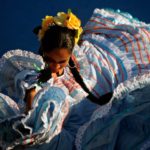…and an Amerasian, “Banana,” and 1.5-er?Asian-American Village Staff Some terms used in our Multiracial Focus edition and other articles related to persons of mixed heritage may not exactly be self-explanatory, so here’s a short glossary to help your reading.
Hapa (or happa) A person with one Asian or Asian-American parent and one non-Asian parent From Brian Niiya’s excellent reference, Japanese American History: An A-to-Z Reference (Japanese American National Museum/Facts On File, 1993): “Evolving from the Hawaiian pidgin term hapa-haole (literally “half-white”), the term had a mildly pejorative connotation at one time [and] has since become widely used, especially in Hawaii.” While some commentators object to the term’s appropriation and perceived misuse outside of its original Hawaiian and colonialist contexts, “hapa” has increasingly entered the local languages and jargons of a variety of Asian ethnic groups both in Hawaii and on the mainland. Amerasian An American with one Asian or part-Asian parent and one non-Asian parent The definition of “Amerasian” has been in flux for many years now. In addition to the above definition, some authorities have reserved the term to describe those children born of Asian mothers (primarily Southeast Asian) and American fathers (usually servicemen)–in the spirit of the Amerasian Homecoming Act of 1987, allowing the transfer of Vietnamese-born, war era Amerasians to the United States. “Amerasian” also enjoyed fleeting use as a term for Americans of Asian ancestry–in lieu of “Oriental,” for example. 1.5 Generation Immigrants and refugees born abroad but educated and socialized in the U.S. Lan Cao and Himilce Novas’ handy reference, Everything You Need to Know About Asian-American History (Plume/Penguin 1996) describes the young 1.5-ers as “a generation straddling two countries and two cultures” who “helped bridge the gap between the older generation(s)” and American-born Asian Americans. “Banana” “Yellow on the outside and white on the inside” A generally derogatory term, similar in usage to “Oreo” among African Americans. “ABC” “American-born Chinese” A commonly used phrase that has caused a number of arguments here among the Village editors, this refers — fairly obviously — to Chinese Americans born in the U.S. “Issei, Nisei, Sansei, Yonsei” “First, Second, Third, Fourth” From the Japanese root for the number one, “Issei” is the designation for immigrants to America — significantly, it has throughout this century conveyed a sense of the first American generation, despite long-standing historical prohibitions on their naturalization. “Nisei” is a designation for the American citizen children born to Issei parents, and so on. While properly speaking, a new immigrant today could be conceived of as an Issei, the terms have come to be associated with specific characteristics of specific generations of Japanese Americans since the first major immigration waves in the late 1800s. Also see:
|
||
|











